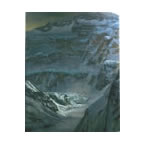 |
|
|
 |
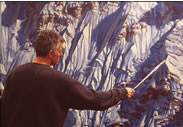 |
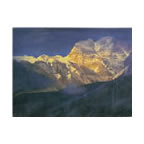 |
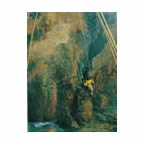 |
 |
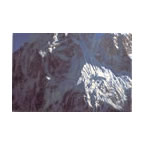 |
 |
 |
Inside is a huge hangar-like space, the walls lined with innumerable canvases, the ceiling covered with yellow spray-on insulation punctuated by corrugated perspex skylights. An industrial heater rumbles in a corner. I notice a mountain bike, a row of paint-crusted tables covered with pots, jars, sketchbooks, photographs, papers; and on the end wall, facing us and dominating the space with its vast, alluring expanse of misty light, Kanchenjunga, North Face, one of the mountain paintings which have been Julian Cooper's preoccupation for the past seven years.
Cooper is blessed and cursed with being the third generation of a Lakeland dynasty. His grandfather, Alfred Heaton Cooper, was a post-Impressionist landscape painter of rugged power; his father, W. Heaton Cooper, a topographical painter in the tradition of Francis Towne. To my taste, W. Heaton's landscapes look pallid and formulaic, but Julian is loyal about his father, affirming his brilliance as a teacher. Nonetheless, his own work has broken the family mould in every way.
Graduating from Goldsmith's in the late 1960s as a realist seduced and challenged by abstraction, he has tackled the major issues of figurative painting head-on The 1980s produced a series of Mexican paintings inspired by Malcolm Lowry's novel Under the Volcano and in the early 90s the Ambleside Interior series tried to problematise landscape by showing the panorama of Lakeland mountains from a balcony where a woman watches a TV screen showing aerial shots of burning Amazonian rain forest.
Though such works brushed aside concerns about 'illustration' and asserted painting's right to a confident, critical relationship with the novel, the electronic media and environmental politics, landscape was still present as backdrop or context for the human. A controlling factor - whether narrative, camera or just balcony rails - kept it in its place.
The process of direct confrontation began in 1995 with a trip to the Andes when Cooper, always a keen mountaineer, began trekking into the mountains carrying rolled-up 7ft by 5ft canvases, which he fixed with bulldog clips to a lightweight temporary stretcher made of aluminium rods like the ones used for rucksack frames. He would paint fast, leaving the canvas on the mountainside over night, and the landscape itself would change as he worked. "This one" (he gestures at a large canvas) "was painted on the edge of a moraine and the glacier was eating it away while I was there. I started out about thirty feet from the edge and by the time I'd finished the edge was about two feet away, and a vast crack was starting to open behind me." As he worked, wind would blow material from the crumbling cliff-edge across the painted surface. "That's real grass and earth in the paint. The picture's ingesting actual parts of the landscape."
But Cooper was still discontented with the established painterly language available for representing nature. It wasn't harsh enough, strange enough, real enough. It was still representation rather than enactment. The breakthrough came in late 1999 when he travelled to paint in the Kanchenjunga region of Nepal. This time he took small canvases (20 by 30in.) and a camera with a telephoto lens to capture detail of the rock in the changing light. He became especially fascinated by the view of mountainside and rockface through binoculars: the disembodied, weightless vision of mountain as text and texture, the trace of eroded rock and sliding snow or ice at points where no-one, not even a mountaineer, can ever go. It was December and bad weather shortened the trip but Cooper brought back the materials and the inspiration for an astonishing series of works.
The new paintings conduct a three-way dialogue between paint, perception and nature. The canvas is acknowledged as a vertical surface: trickles and runs of paint are encouraged as an expression of gravity, the same force that drags ice, snow and water down the rockfaces. A free, calligraphic brushwork creates rich, dramatic abstract passages, often with the paint so thin that spots of the warm earth-coloured grounds are visible between the chilly deep blues, slates and off-whites that recreate the hues of rock-slab and glacier.
As the viewer moves back from the canvas the drama of sheer texture and colour begins to resolve into figuration. It's hard to use the word landscape because the picturesque tradition is simply ignored. In Kanchenjunga, North Face the summit - that culmination of Romantic landscape apprecation - is absent, sliced off by the top of the canvas. Instead we are confronted with an enormous surface of deeply-furrowed rock, of pocketed, ledged and corniced snow, and a scatter of light, bouncing off some rough pinnacles at one edge and caught in the cup-like hollow of a glacier towards the foot of the canvas. At the same time the drama of the paint is unrelenting. We're aware of the rockface assembling itself from the marks on the canvas, the creative process as an edgy, precarious dance where paint, canvas, rock, ice and snow all have their presence, and are all, equally, inhuman and enigmatic.
Cooper gestures at the canvas, which hangs from vertical shelving-track screwed to the wall. " I'm still working on this one. Its been done in a series of drafts working all over the surface and now it's ready for the final draft or scan or whatever. I go over the whole surface from top to bottom tightening up, making some bits of the paint more fleshy, more thick, leaving other bits and generally going over the whole thing. … But I have to be very careful because it's all to do with inflexions. It's a picture of a vast surface and very inaccessible - I don't want to domesticate it too much, or make it too much a product of someone's hand. I want to feel that it's out there over there and it's also a result of time and weather and thousands and thousands of years. It's a very delicate operation."
Cooper's recent work is currently spread out around Cumbria, so we leave the studio and head over the bleak fell-tops near Shap, where it's starting to rain, to the Rheged Visitor Centre near Penrith. "Tony Blair was here a few weeks ago to open an exhibition on the history of mountaineering," Cooper explains, "and the painting the British Mountaineering Council had commissioned wasn't finished so we swapped it for a smaller one. The picture that should have been here is in a barn right now while I finish it. We'll go and see that after lunch."
Currently occupying the space, at the top of a high wall above an escalator, is Swing. A nepali girl in yellow swings out vertiginously on a frail swing supported on bamboo poles, over a vast gulf - mountainside again - in which delicate green farm-terraces can be made out, clinging to the precipitous slopes, as well as a dark vertical fissure in the rock and glimpses of a river at the bottom of the gorge. Again, no sky is visible. The interplay between green cultivation and dry, yellowish rock is as evident as the spatial drama set up between the viewer, looking down on the swinger, who in turn gazes down into the massive space below.
It strikes me that Cooper is unusual in using iconography almost as a Renaissance painter might have done, the elements chosen as indicators of major cultural and philosophical themes. This is a picture about vulnerability, about a precarious relationship between humanity and nature; and, as often in Cooper's earlier paintings, there's a woman at the focal point.
The impression is confirmed when, leaving Penrith and driving along a maze of country lanes, we reach the huge seventeenth-century stone barn (`a winnowing barn', Cooper tells me) where Scafell Crag, the Mountaineering Council's commission, is hanging. Cooper hauls open the doors to let the light in. A cow pushes a breathy nose through a hole in a wooden door at the back, curious to know what's going on.
At 13 ft by 7 the canvas looks huge. It reaches up to the rafters, and Cooper has a scaffolding tower (he owns two) set up in the barn to reach the upper areas. The bare sandstone walls of the vast, silage-smelling space make a strange but appropriate setting. The painting shows a buttress near the foot of Scafell, backed by the boulder-strewn lower slopes of the mountain. Three climbers are making their way up and the lowest of them, at the foot of the canvas but painted in bold strokes and reaching a foreshortened arm right out of the picture-plane to grab the next handhold, is a young woman. There is a drama in the intensity of her gaze and the sense of effort and determination is continued in the thick, economical strokes that create her face and the light that catches her forehead.
Cooper is currently placing a group of tiny, almost invisible climbers on the rocks in the background. He wants viewers to discover them with surprise after looking at the picture for some time, the way you do when you're in the mountains and suddenly spot climbers in an apparently empty landscape. "But", he says ruefully," the Council have been more concerned that he gets the details of the routes up the rockface correct: there will be a lot of critical eyes on this painting, and most of them won't belong to art critics". An experienced climber himself, Cooper understands their concern. "Climbers", he says, "are used to 'read' rock, tracing the possible routes up it, checking out favourite details".
It's this hands-on knowledge of the sheer density and texture of the mountains that's communicated by the muscular handgrasp of the girl at the front of the picture, but the same respect for physicality is there in the grittiness of the paint, the fractured and fissured irregularities of pigment, the determination to let physical processes of paint and brushwork speak for themselves.
We go back across the cobbled farmyard and head off for Grasmere, where a group of the latest Himalayan paintings are on show at the Wordsworth Trust's 3°W Gallery. As we drive, Cooper talks about his admiration for "those dogmas from 1950s American Expressionism, about keeping a sense of flatness, of a flat surface. I'll never get rid of all that stuff. People like Rothko and Barnett Newman, there was a sort of importance about acknowledging the flatness, the objectness of the painting. I still subscribe to that. I don't want to concentrate on illusion in an obvious sort of way. To hide the painting process away, it's bad manners."
The tiny 3°W Gallery (it used to be a village shop) seems almost blown apart by the scale and intensity of the paintings. In the small, angular rooms it's hard to stand back far enough but several of the canvases have the impact of windows punched through the walls onto immense vistas of light and snow. Lightpatch (50 by 76 in) contrasts areas of thick impasto, where broken and furrowed snow catches oblique sunlight, with chaotically intricate, thinly-glazed areas of cerulean and greenish-grey that create the shadowed and pitted rockface.
Fluted Ridge (78 by 60 in) confronts a precipitous acreage of snow split by a multitude of vertical corrugations thrown into deep shadow by late-afternoon sun. Here, as in the even larger Headwall (96 by 84 in), where bands of warm stone cut across curtain-like ruched folds of crusted snow suspended on the vertical surface, there's no sky and no human figure, yet surprisingly the sense of scale is overpowering. The broad brushstrokes, erupting into tangles of finer, calligraphic work within the massively insistent overall composition, somehow create a sense of hanging in space opposite the overpowering enigma of this surface which offers as little fingerhold for interpretation as it would to a climber. The surface is offered as totally accessible to the eye, yet resisting all human purposes.
In their uncompromising treatment of the world's structures and balances, Julian Cooper's paintings clearly have ecological implications. Partly it's a matter of respect: acknowledging nature, and the painter's materials, in a way that leaves their mystery and meaning, or even lack of meaning, intact. But it goes further. Nature is presented not just as an object of contemplation, but as something that might be contemplating us too, something too big for any picture to encompass "The mountains have this immense presence," says Cooper. "There's an energy about them that doesn't come from somewhere outside. It's inherent in them."As we drive back to Kendal I try to draw him into more precise formulations but he resists and declares his distrust of words like 'spiritual' and 'mystical'.
But as we turn off the road by the disused factory and head for his industrial unit, he makes one concession. 'Painting's a bit like alchemy, I suppose,' he muses. 'It's one of the last human activities where people mess about with material stuff and hope for something to happen - something that isn't material at all.'
Click here to view Julian's earlier paintings at his website
GREVEL
LINDOP is a poet, critic and biographer, and former Professor of Romantic
Studies at Manchester University. He writes regularly for the TLS and
other journals. His Selected Poems appeared in 2000; the final volumes
of his collected edition of De Quincey's works will appear in autumn 2002.
He is currently working on a biography of the poet, novelist and mystic
Charles Williams.
